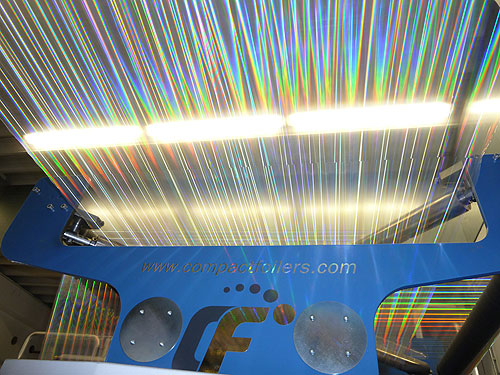
by Melissa DeDonder, PostPress

In the highly competitive world of retail, products need to stand out on the shelves. Breit Technologies, Keystone Paper and Box Company, Inc. and the EGC Group collaborated to produce a holographic package that won a Silver Award in the Best Use of Film Casting (Cast and Cure™) category during the Foil & Specialty Effects Association’s 22nd Annual Gold Leaf Awards competition.
The award-winning holographic packaging was created in honor of the 10-year anniversary of one of Blue Point Brewing Company’s most popular brews – the Hoptical Illusion. “The package designers wanted something special, and they embraced the clear holographic design element as a means to pique curiosity and enhance shelf appeal,” said Jim Rutt, president of Keystone Paper and Box Company.
The name of the brew and its psychedelic-themed branding pays homage to ancient Egyptian folklore – the idea that pillows stuffed with hops would elicit intense, vivid dreams. The brew’s packaging features multiple patterns, bright colors and distorted fonts, which presented a monumental challenge in terms of finding the right holographic pattern and application. “Typically, Cast and Cure is used with solid colors or with less busy backgrounds, so the psychedelic theme required several rounds of testing and proofs to find the right fit,” said Tim Cain, president of Breit Technologies LLC in Overland Park, Kansas. Breit Technologies is credited with introducing Cast and Cure in North America.
The Cast and Cure decorative process, also known as film casting, is beginning to flourish in the marketplace. The process uses UV/EB varnishes and specialty films to create diffractive surfaces that produce unique finishes for the printing and packaging industries. A consistent high-quality surface is created, which can incorporate ultra-high gloss, matte and holographic finishes on a variety of substrates – an effect that can be created in both sheet-fed (offset) and web-fed (flexo and gravure) environments.
To achieve the effect, wet UV or EB varnish is applied to a substrate based on either spot or flood coverage needs. Once the varnish is applied, the Cast and Cure film is temporarily laminated to the substrate with an image or pattern – holographic, matte, etc. The film acts as an embossing tool to manipulate the surface of the coating on a submicron scale. The lamination creates a “cased” image in the surface of the varnish, and then the varnish is UV- or EB-cured with the casting film still in place. Finally, the film is delaminated and stripped away, leaving the desired pattern on the surface of the substrate. No material or film is transferred to the surface, so the film can be rewound and used multiple times.
In the Hoptical Illusion packaging, to complete the decorative process, the film was first compressed against the wet UV coating and then UV cured. The film was then stripped away, leaving a bright, clear holographic effect that enhanced the printed graphics without overwhelming the look of the carton.
The effect was produced on a module manufactured by Compact Foilers Limited, which had been retrofitted to the last station of an existing offset printing press. “This machine is unique because it can be loaded from the floor, and the tension controls ensure excellent laydown, which allows for graduated screens and very fine lines of foil can be put down,” Rutt said.
Rutt said the feedback from the Hoptical Illusion project and other projects utilizing Cast and Cure has been positive. “It has opened doors for our company, and our customers keep requesting the process,” he said. The greatest testament for Cast and Cure may be in the increased efficiency and sustainability that it provides. “Once we learned the process, the mileage we are able to get out of the film just keeps getting better. After a couple of runs, we exceeded 20 turns on a 5,000 meter roll of film. In our most recent run, we exceeded 30 turns,” Rutt said.
During the past 10 years, the process has been used on multiple $500 million and $1 billion dollar brands around the world. Cain believes this success is the result of Cast and Cure being the most cost-effective method of achieving a holographic effect in the marketplace today. “The reusability of the casting film – up to 20+ times potentially – provides exponential cost savings, which makes the process more attractive than many other decorative techniques,” Cain said.
The fact that the film can be reused several times not only serves as a cost benefit, but also as a sustainability benefit – reducing the amount of material needed to decorate mass quantities of packages. In addition, other sustainability contributions of Cast and Cure include lighter packaging because nothing is transferred from the casting film to the substrate; no material in the landfill because the casting films are recyclable – as opposed to the laminated metalized films used in traditional holographic processes; and the elimination of volatile organic compounds (VOCs) with the use of UV/EB varnishes. These benefits work together to reduce the carbon footprint and lower expenses overall.
Cast and Cure is is a highly flexible technique because it can be spot applied to enhance specific areas. Since the effect is clear, it does not interfere with existing graphics and – unlike holographic laminates – there is no need to use opaque white to cover up the areas where no effect is desired. In the Hoptical Illusion packaging, the psychedelic theme draws attention to consumers looking to grab a beverage from retail shelves. See the UV+EB Technology article in Issue 3 for the carton photo, illustration from Breit and captions.

